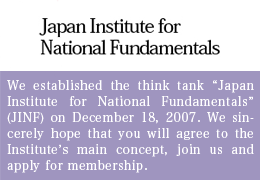Japan Should Demonstrate Convincing Safety Measures for Nuclear Power Generation
On June 27, Prime Minister Naoto Kan appointed special aid Goshi Hosono as minister in charge of the ongoing nuclear crisis. Hosono’s assignment also includes preventing future accidents at the nation’s nuclear power plants.
Just three days earlier, Hosono was a guest speaker at a seminar entitled “The Facts and Fictions of Radiation Damage,” sponsored by the Japan Institute for National Fundamentals (JINF), a Tokyo-based private think tank which I head. Claiming he would stop being a politician if he fail to “bring the current disaster under control,” he stressed that the degree of control the operator of the Fukushima Daiichi Nuclear Power Complex exercises over each of its (four troubled) reactors “has steadily been increasing.”
Hosono noted, for example, that it will be possible to allow the nuclear refugees at various shelters in Fukushima Prefecture to return to their homes in the no-entry zone (basically within a 20-kilometer radius of the plant) when the operator - the Tokyo Electric Power Company (TEPCO) - manages to lower the percentage of hydrogen in the reactors with an infusion of nitrogen, eliminating the possibility of hydrogen explosions. “We are hoping to accomplish this by July 17,” declared Hosono.
Broadly speaking, TEPCO’s Fukushima complex has been gradually brought under control. However, as will be mentioned later, it is extremely difficult - or, even next to impossible - to trust any information disseminated by members of the current Democratic Party of Japan (DPJ) administration, including Hosono himself. That is why Hosono in his new position, as well as Banri Kaieda, Minister of Economy, Trade, and Industry, should particularly take the following to heart: Fukushima has clearly given the international community a shock that is far more serious than Chernobyl. The world’s distrust of Japan has deepened perilously chiefly because of two elements - 1) TEPCO’s shoddy corporate character revealed through its handling of the disaster, and 2) the appallingly amateurish responses to the national crisis by DPJ’s top echelon, from the prime minister down.
At the outset, discussing Fukushima on the same level as Chernobyl was generally viewed as unfair because the amount of radioactive particles emitted into the air was initially believed to be held to roughly one tenth that of Chernobyl. However, due to the multiplying negative effects of the incompetent management of TEPCO and the DPJ administration, experts now unanimously acknowledge that Fukushima has had a far more serious impact on the international community than its Ukrainian counterpart.
The international community is desperately trying to learn from the Fukushima disaster in order to enhance the safety of nuclear power stations around the world. And yet, it is stunned by certain abnormalities involving Japan’s nuclear power generation, TEPCO’s peculiar corporate nature being at the top of the list. The utility has laid bare its total lack of thorough precautions, preparations, and discretion - the key ingredients required in managing the tremendous energy generated by nuclear power plants. Unbelievably, none of TEPCO’s top management has had hands-on experience at a nuclear power plant. It was due presumably to this lack of expertise that comprehensive measures were not in place for severe accident management. What then is the real expertise of these so-called executives? The only conclusion that can be reached is that they are essentially specialists in the art of dealing with the politicians who have jurisdiction over the nation’s nuclear power administration. Such an assumption leads one to easily conclude why TEPCO’s management has repeatedly come up with such naive countermeasures.
Japanese Government Viewed as “Incompetent”
Actually, immediately following the quake and tsunami, there were some indications of major trouble at the no. 1 reactor, which subsequently suffered a hydrogen explosion that became a critical turning point in the crisis. That became apparent at 1:20 a.m. on March 12, when TEPCO - following Article 15 of the Nuclear Disaster Special Measures Law - reported an emergency to the Ministry of Economy, Trade, and Industry. The emergency in question resulted from a failure to pour water into the reactor because of power failure, making it impossible to sustain cooling functions for the reactor. Despite the fact that TEPCO should have taken the speediest steps possible to safeguard the safety of its plant, it took action only belatedly. One can only surmise they put the highest priority on how to deal with the prime minister, who had suddenly decided to inspect the crippled plant at 7:30 a.m. on that day.
At the time, Kan’s office agreed during an emergency meeting that pressure within the no. 1 reactor building should be lowered by venting high-temperature steam. This instruction was relayed to TEPCO by minister Kaieda at 1:30 a.m. Incidentally, whether or not to take action to vent steam is a matter that should primarily have been decided by TEPCO, not by the prime minister’s office.
Once the prime minister decided he would indeed inspect the site, TEPCO officials were further confounded by his movements. Kan left his official residence to board a Japan Air Self Defense Force helicopter at 6 a.m. and arrived at his destination at 7:19 a.m., where he immediately entered TEPCO’s earthquake proof disaster headquarters.
Already at the time, a critical situation was evolving at the no. 1 reactor. Within four hours after the tsunami, nuclear fuel within the reactor had begun melting down. At 6:50 a.m. - 15 hours and 20 minutes after the tsunami - most of the fuel had melted, falling to the bottom of the pressure vessel. During this time frame, TEPCO’s top management did virtually nothing to effectively cope with the disaster as they attended to the visiting prime minister.
TEPCO management’s response to the disaster was truly unpardonable: Their outlook of the course the disaster would take was simply too optimistic, and they absolutely lacked any sense of crisis. It must also be pointed out that the government’s faulty response contributed significantly to the worsening of the situation. The International Atomic Energy Agency (IAEA), during a June 21-22 closed-door working team meeting, pointed out that political intervention by the Kan administration invited unnecessary confusion among those coping with the disaster on the spot. (The Sankei Shimbun, June 22)
Describing as “extremely opaque” the information disclosed by the Japanese government on the nuclear disaster, the IAEA was quoted by the daily as concluding: “There has actually been no proof that the Japanese government was indeed covering up information. Instead, we believe they just lacked pertinent information.”
In other words, the IAEA believes the Japanese government failed to come to grips with the scope of the nuclear disaster at the initial stage, concluding that it was “grossly incompetent” to handle the developing situation.
The biggest fault of the government vis-a-vis disaster countermeasures lies in the slowness of its decision-making and implementation of countermeasures. For instance, Hosono explained that the government currently is making its utmost efforts to enact measures to cope with tons of contaminated water at the Fukushima plant, and that once that is done they will then tackle the contamination of school grounds and public roads, followed by the issue of reprocessing spent nuclear fuel. I completely disagree with such an approach, because I believe all these problems must be tackled simultaneously. Particularly, the government can ill afford to cope with the contamination of water and soil on a step-by-step basis, as this most directly and seriously affects the daily lives of the people. In fact, some local governments and residents have become so impatient with government procrastination they have already taken steps on their own to begin removing radiation from roads and the surface soil of school grounds.
Confronted with these facts, Hosono said: “When all these problems are presented to the people all at once, I am afraid they will not be able to come to grips with what the government is up to.” I disagree. I must emphasize that it is the responsibility of every politician under democracy to exert his utmost effort to make himself understood by the people.
Lack of Science in Japan’s Nuclear Power Administration
Another problem with the information disseminated by the prime minister’s office is the lack of scientific consistency and substantive facts. A typical example involves the request the government made in early May to the operator of the Hamaoka nuclear power plant in Shizuoka Prefecture, central Japan. Prime Miniser Kan asked the Western Japan Power Company to close the plant until safety measures are worked out, on the grounds that there is “an 87 percent chance of a ‘Tokai area’ earthquake of magnitude 8.0 or so hitting the area within the next 30 years.” However, Kan said he views the other nuclear power stations elsewhere in Japan as “safe.” The prime minister told the nation he based his decision on the view entertained by himself and minister Kaieda that the other nuclear complexes are “presumed safe” by experts. The international community must certainly have regarded this unconvincing logic of Kan’s, which clearly reflects his desire to increase his administration’s approval rating among those not favoring nuclear power generation, as symbolic of a stunning lack of science in Japan’s nuclear power administration.
I am afraid the remarks Mr. Kan made at Deauville, France, during this year’s summit also may have cost Japan some of the trust and confidence the world still had in it. He said that by the early 2020s the Japanese government will raise the amount of electricity producible from renewable energy to 20 percent of the total national electricity output. However, this is far easier said than done. Actually, the goal Kan projects would not be attainable even if all of the coastal regions of the Japanese archipelago were to be equipped with wind turbines - or if solar panels were to be installed atop 10 million Japanese homes, as he specifically pledged in Deauville. As prime minister of Japan, Mr. Kan ought to be a little more mindful that he should refrain from speaking irresponsibly.
Hosono said he values the prime minister as “cool-headed,” but I feel heツ黴 needs to stay more focused on overcoming the impending electricity crisis of this summer, and not get caught up in the nonsensical remarks the prime minister will most likely keep repeating as he tries to maintain his standing in the polls. Another vital role Hosono can and should play is to trust the people and disclose all pertinent information concerning the nuclear crisis, helping to enhance the safety of atomic power plants in ways that are clearly understood by the general populace. At a time when the government, TEPCO, and the Atomic Energy Safety Commission - which has over the years acted in lock step with the utility - are all yet to win public confidence, it is necessary to ツ黴seriously consider the need for Japan to gain the cooperation of the international community as an interested new third party. With this support, we then need to develop the best mix between nuclear power generation and renewable energy as a grand energy strategy for the future of Japan.
(Translated from “Remaissance Japan” column no. 467 in the July 7, 2011 issue of The Weekly Shincho.)








